Temporal Variability of Temperature Extremes in the Sardinia Region (Italy)
Abstract
:1. Introduction
2. Study Area and Data
3. Methodology
4. Results
4.1. Analysis of the Monthly Minimum Temperature
4.2. Analysis of the Monthly Maximum Temperature
4.3. Analysis of the Extreme Temperature Indices
5. Discussion
6. Conclusions
- (a)
- For the minimum temperature series, diffuse negative tendencies have been identified, with a positive trend observed only in the spring months;
- (b)
- For the maximum temperature series, a general increasing trend has been identified in almost all the months, with the exclusion of January, September, December and, partially, October. In particular, a consistent positive trend in the spring and in the summer months has been detected, especially in June;
- (c)
- Among the evaluation of the indices of extreme temperatures, the DTR results evidenced a marked increasing trend distributed across the region. The frost days (FD) showed a positive trend of the series mainly localized around the eastern mountain and in the southwestern side of the region. The summer days (SU25) displayed more positive trends than negative ones, spatially distributed all over the region. The tropical nights (TR20) showed an equal distribution of positive and negative trends. Finally, both the warm (WSDI) and the cold (CSDI) spell indices displayed an increasing trend localized in the southern part of the region.
- (d)
- Results indicate that Sardinia’s topography may cause temperature variability. In fact, the mountains crossing the island constitute a barrier between the tropical air masses coming from the African coasts on eastern side, and air masses carried by western winds originating from the Atlantic Ocean on the western side. The changes in the temperature regime in this region could have regionally specific impacts on its ecosystems.
- (e)
- These results can be very useful for several stakeholders. In particular: (i) planners, disaster management agencies and policy makers who need to be alert in a region with a high-density population; (ii) hydrologists and climatologists who need to investigate the potential causes of the observed temporal trends to delineate the variability of extremes due to natural and anthropogenic effects.
Author Contributions
Funding
Conflicts of Interest
References
- IPCC. Summary for Policymakers. Fifth Assessment Report of the Intergovernmental Panel on Climate Change; Cambridge University Press: Cambridge, UK, 2013. [Google Scholar]
- Tol, R.S.J. Population and trends in the global mean temperature. Atmósfera 2017, 30, 121–135. [Google Scholar] [CrossRef] [Green Version]
- Folland, C.K.; Boucher, O.; Colman, A.; Parker, D.E. Causes of irregularities in trends of global mean surface temperature since the late 19th century. Sci. Adv. 2018, 4, eaao5297. [Google Scholar] [CrossRef] [PubMed] [Green Version]
- Mahmoudi, P.; Mohammadi, M.; Daneshmand, H. Investigating the trend of average changes of annual temperatures in Iran. Int. J. Environ. Sci. Technol. 2019, 16, 1079–1092. [Google Scholar] [CrossRef]
- Salman, S.A.; Shahid, S.; Ismail, T.; Ahmed, K.; Chung, E.S.; Al-Abadi, A.M. Long-term trends in daily temperature extremes in Iraq. Atmos. Res. 2018, 198, 97–107. [Google Scholar] [CrossRef]
- Sirangelo, B.; Caloiero, T.; Coscarelli, R.; Ferrari, E. A stochastic model for the analysis of maximumdaily temperature. Theor. Appl. Climatol. 2017, 130, 275–289. [Google Scholar] [CrossRef]
- Pellicone, G.; Caloiero, T.; Guagliardi, I. The De Martonne aridity index in Calabria (Southern Italy). J. Maps 2019, 15, 788–796. [Google Scholar] [CrossRef]
- Pellicone, G.; Caloiero, T.; Modica, G.; Guagliardi, I. Application of several spatial interpolation techniques to monthly rainfall data in the Calabria region (southern Italy). Int. J. Climatol. 2018, 38, 3651–3666. [Google Scholar] [CrossRef]
- Cao, L.; Zhang, Y.; Shi, Y. Climate change effect on hydrological processes over the Yangtze River basin. Quat. Int. 2011, 244, 202–210. [Google Scholar] [CrossRef]
- Keellings, D.; Waylen, P. The stochastic properties of high daily maximum temperatures applying crossing theory to modelling high-temperature event variables. Theor. Appl. Climatol. 2012, 108, 579–590. [Google Scholar] [CrossRef]
- Munich, R. TOPICS Geo 2003; Münchener Rückverischerungs-Gessellschaft: Munich, Germany, 2004. [Google Scholar]
- García-Herrera, R.; Díaz, J.; Trigo, R.M.; Luterbacher, J.; Fischer, E.M. A Review of the European Summer Heat Wave of 2003. Crit. Rev. Environ. Sci. Technol. 2010, 40, 267–306. [Google Scholar] [CrossRef]
- UNEP. The European Summer Heat Wave of 2003; United Nations Environmental Programme: Nairobi, Kenya, 2004. [Google Scholar]
- Buttafuoco, G.; Caloiero, T.; Ricca, N.; Guagliardi, I. Assessment of drought and its uncertainty in a southern Italy area (Calabria region). Measurement 2018, 113, 205–210. [Google Scholar] [CrossRef]
- Buttafuoco, G.; Caloiero, T.; Guagliardi, I.; Ricca, N. Drought assessment using the reconnaissance drought index (RDI) in a southern Italy region. In Proceedings of the 6th IMEKO TC19 Symposium on Environmental Instrumentation and Measurements, Reggio Calabria, Italy, 24–25 June 2016; pp. 52–55. [Google Scholar]
- Ricca, N.; Guagliardi, I. Multi-temporal dynamics of land use patterns in a site of community importance in Southern Italy. Appl. Ecol. Environ. Res. 2015, 13, 677–691. [Google Scholar]
- Cornes, R.; van der Schrier, G.; van den Besselaar, E.J.M.; Jones, P.D. An Ensemble Version of the E-OBS Temperature and Precipitation Datasets. J. Geophys. Res. Atmos. 2018, 123, 9391–9409. [Google Scholar] [CrossRef] [Green Version]
- Mistry, M.N. A High-Resolution Global Gridded Historical Dataset of Climate Extreme Indices. Data 2019, 4, 41. [Google Scholar] [CrossRef] [Green Version]
- Moberg, A.; Jones, P.D. Trends in indices for extremes in daily temperature and precipitation in central and western Europe analyzed 1901–1999. Int. J. Climatol. 2005, 2, 1149–1171. [Google Scholar] [CrossRef]
- Croitoru, A.E.; Piticar, A. Changes in daily extreme temperatures in the extra-Carpathians regions of Romania. Int. J. Climatol. 2013, 33, 1987–2001. [Google Scholar] [CrossRef]
- Toll, V.; Post, P. Daily temperature and precipitation extremes in the Baltic Sea region derived from the BaltAn65+ reanalysis. Theor. Appl. Climatol. 2018, 132, 647–662. [Google Scholar] [CrossRef]
- Insaf, T.Z.; Lin, S.; Sheridan, S.C. Climate trends in indices for temperature and precipitation across New York state, 1948–2008. Air Qual. Atmos. Health 2012, 6, 247–257. [Google Scholar] [CrossRef]
- Lopez-Franca, N.; Zaninelli, P.G.; Caril, A.F.; Menendez, C.G.; Sanchez, E. Changes in temperature extremes for 21st century scenarios over South America derived from a multi-model ensemble of regional climate models. Clim. Res. 2016, 68, 151–167. [Google Scholar] [CrossRef]
- Meseguer-Ruiz, O.; Ponce-Philimon, P.I.; Quispe-Jofré, A.S.; Guijarro, J.A.; Sarricolea, P. Spatial behaviour of daily observed extreme temperatures in Northern Chile (1966-2015): Data quality, warming trends, and its orographic and latitudinal effects. Stoch. Environ. Res. Risk Assess. 2018, 32, 3503–3523. [Google Scholar] [CrossRef] [Green Version]
- Shen, X.; Liu, B.; Lu, X.; Fan, G. Spatial and temporal changes in daily temperature extremes in China during 1960–2011. Theor. Appl. Climatol. 2017, 130, 933–943. [Google Scholar] [CrossRef]
- Chen, A.; He, X.; Guan, H.; Cai, Y. Trends and periodicity of daily temperature and precipitation extremes during 1960–2013 in Hunan Province, central south China. Theor. Appl. Climatol. 2018, 132, 71–88. [Google Scholar] [CrossRef]
- Caloiero, T. The trend of monthly temperature and daily extreme temperature during 1951–2012 in New Zealand. Theor. Appl. Climatol. 2017, 129, 111–127. [Google Scholar] [CrossRef]
- Shrestha, A.B.; Bajracharya, S.R.; Sharma, A.R.; Duo, C.; Kulkarni, A. Observed trends and changes in daily temperature and precipitation extremes over the Koshi river basin 1975–2010. Int. J. Climatol. 2017, 37, 1066–1083. [Google Scholar] [CrossRef] [Green Version]
- Chakraborty, D.; Sehgal, V.K.; Dhakar, R.; Varghese, E.; Das, D.K.; Ray, M. Changes in daily maximum temperature extremes across India over 1951–2014 and their relation with cereal crop productivity. Stoch. Environ. Res. Risk Assess. 2018, 32, 3067–3081. [Google Scholar] [CrossRef]
- Dimri, A.P. Comparison of regional and seasonal changes and trends in daily surface temperature extremes over India and its subregions. Theor. Appl. Climatol. 2019, 136, 265–286. [Google Scholar] [CrossRef]
- Filahi, S.; Tanarhte, M.; Mouhir, L.; El Morhit, M.; Tramblay, Y. Trends in indices of daily temperature and precipitations extremes in Morocco. Theor. Appl. Climatol. 2016, 124, 959–972. [Google Scholar] [CrossRef]
- Halimatou, A.T.; Kalifa, T.; Kyei-Baffour, N. Assessment of changing trends of daily precipitation and temperature extremes in Bamako and Ségou in Mali from 1961-2014. Weather Clim. Extrem. 2017, 18, 8–16. [Google Scholar] [CrossRef]
- Salman, S.A.; Shahid, S.; Ismail, T.; Ahmed, K.; Chung, E.S.; Wang, X.J. Characteristics of Annual and Seasonal Trends of Rainfall and Temperature in Iraq. Asia-Pac. J. Atmos. Sci. 2019, 55, 429–438. [Google Scholar] [CrossRef]
- Giorgi, F. Climate change hot-spots. Geophys. Res. Lett. 2006, 33, L08707. [Google Scholar] [CrossRef]
- Hertig, E.; Seubert, S.; Jacobeit, J. Temperature extremes in the Mediterranean area: Trends in the past and assessments for the future. Nat. Hazards Earth Syst. Sci. 2010, 10, 2039–2050. [Google Scholar] [CrossRef]
- Efthymiadis, D.; Goodess, C.M.; Jones, P.D. Trends in Mediterranean gridded temperature extremes and large-scale circulation influences. Nat. Hazards Earth Syst. Sci. 2011, 11, 2199–2214. [Google Scholar] [CrossRef]
- Brunetti, M.; Maugeri, M.; Monti, F.; Nanni, T. Temperature and precipitation variability in Italy in the last two centuries from homogenised instrumental time series. Int. J. Climatol. 2006, 26, 345–381. [Google Scholar] [CrossRef]
- Colombo, T.; Pelino, V.; Vergari, S.; Cristofanelli, P.; Bonasoni, P. Study of temperature and precipitation variations in Italy based on surface instrumental observations. Glob. Planet. Chang. 2007, 57, 308–318. [Google Scholar] [CrossRef]
- Ciccarelli, N.; Von Hardenberg, J.; Provenzale, A.; Ronchi, C.; Vargiu, A.; Pelosini, R. Climate variability in north-western Italy during the second half of the 20th century. Glob. Planet. Chang. 2008, 63, 185–195. [Google Scholar] [CrossRef]
- Pellicone, G.; Caloiero, T.; Coletta, V.; Veltri, A. Phytoclimatic map of Calabria (Southern Italy). J. Maps 2014, 10, 109–113. [Google Scholar] [CrossRef] [Green Version]
- Caloiero, T.; Buttafuoco, G.; Coscarelli, R.; Ferrari, E. Spatial and temporal characterization of climate at regional scale using homogeneous monthly precipitation and air temperature data: An application in Calabria (Southern Italy). Hydrol. Res. 2015, 46, 629–646. [Google Scholar] [CrossRef]
- Caloiero, T.; Callegari, G.; Cantasano, N.; Coletta, V.; Pellicone, G.; Veltri, A. Bioclimatic analysis in a region of southern Italy (Calabria). Plant Biosyst. 2015, 150, 1282–1295. [Google Scholar] [CrossRef]
- Sirangelo, B.; Caloiero, T.; Coscarelli, R.; Ferrari, E. A combined stochastic analysis of mean daily temperature and diurnal temperature range. Theor. Appl. Climatol. 2019, 135, 1349–1359. [Google Scholar] [CrossRef]
- Toreti, A.; Desiato, F. Temperature trend over Italy from 1961 to 2004. Theor. Appl. Climatol. 2008, 91, 51–58. [Google Scholar] [CrossRef]
- Simolo, C.; Brunetti, M.; Maugeri, M.; Nanni, T.; Speranza, A. Understanding climate change-induced variations in daily temperature distributions over Italy. J. Geophys. Res. Atmos. 2010, 115, D22110. [Google Scholar] [CrossRef]
- Acquaotta, F.; Fratianni, S.; Garzena, D. Temperature changes in the North-Western Italian Alps from 1961 to 2010. Theor. Appl. Climatol. 2015, 122, 619–634. [Google Scholar] [CrossRef]
- Tomozeiu, R.; Pavan, V.; Cacciamani, C.; Amici, M. Observed temperature changes in Emilia-Romagna: Mean values and extremes. Clim. Res. 2006, 31, 217–225. [Google Scholar] [CrossRef]
- Scorzini, A.R.; Di Bacco, M.; Leopardi, M. Recent trends in daily temperature extremes over the central Adriatic region of Italy in a Mediterranean climatic context. Int. J. Climatol. 2018, 38, e741–e757. [Google Scholar] [CrossRef]
- Bartolini, G.; Di Stefano, V.; Maracchi, G.; Orlandini, S. Mediterranean warming is especially due to summer season. Evidences from Tuscany (central Italy). Theor. Appl. Climatol. 2012, 107, 279–295. [Google Scholar] [CrossRef]
- Piccarreta, M.; Lazzari, M.; Pasini, A. Trends in daily temperature extremes over the Basilicata region (southern Italy) from 1951 to 2010 in a Mediterranean climatic context. Int. J. Climatol. 2015, 35, 1964–1975. [Google Scholar] [CrossRef]
- Caloiero, T.; Coscarelli, R.; Ferrari, E.; Sirangelo, B. Trend analysis of monthly mean values and extreme indices of daily temperature in a region of southern Italy. Int. J. Climatol. 2017, 37, 284–297. [Google Scholar] [CrossRef]
- Mann, H.B. Nonparametric tests against trend. Econom. J. Conom. Soc. 1945, 13, 245–259. [Google Scholar] [CrossRef]
- Kendall, M.G. Rank Correlation Methods; Hafner Publishing Company: New York, NY, USA, 1962. [Google Scholar]
- Montaldo, N.; Sarigu, A. Potential links between the North Atlantic Oscillation and decreasing precipitation and runoff on a Mediterranean area. J. Hydrol. 2017, 553, 419–437. [Google Scholar] [CrossRef]
- Beck, H.E.; Zimmermann, N.E.; McVicar, T.R.; Vergopolan, N.; Berg, A.; Wood, E.F. Present and future Köppen-Geiger climate classification maps at 1-km resolution. Sci Data 2018, 5, 180214. [Google Scholar] [CrossRef] [Green Version]
- Regione Sardegna. Available online: http://www.regione.sardegna.it/j/v/25?s=131338&v=2&c=5650&t=1 (accessed on 28 July 2020).
- Caloiero, T.; Coscarelli, R.; Gaudio, R. Spatial and temporal variability of daily precipitation concentration in the Sardinia region (Italy). Int. J. Climatol. 2019, 39, 5006–5021. [Google Scholar] [CrossRef]
- Caloiero, T.; Coscarelli, R.; Gaudio, R.; Leonardo, G.P. Precipitation trend and concentration in the Sardinia region. Theor. Appl. Climatol. 2019, 137, 297–307. [Google Scholar] [CrossRef]
- Caloiero, T.; Veltri, S. Drought assessment in the Sardinia region (Italy) during 1922–2011 using the standardized precipitation index. Pure Appl. Geophys. 2019, 176, 925–935. [Google Scholar] [CrossRef]
- Barrera-Escoda, A.; Gonçalves, M.; Guerreiro, D.; Cunillera, J.; Baldasano, J.M. Projections of temperature and precipitation extremes in the North Western Mediterranean Basin by dynamical downscaling of climate scenarios at high resolution (1971–2050). Clim. Chang. 2014, 122, 567–582. [Google Scholar] [CrossRef]
- Fioravanti, G.; Piervitali, E.; Desiato, F. Recent changes of temperature extremes over Italy: And index-based analysis. Theor. Appl. Climatol. 2016, 123, 473–486. [Google Scholar] [CrossRef]
- El Kenawy, A.M.; Lopez-Moreno, J.I.; McCabe, M.F.; Robaa, S.M.; Domínguez-Castro, F.; Peña-Gallardo, M.; Trigo, R.M.; Hereher, M.E.; Al-Awadhi, T.; Vicente-Serrano, S.M. Daily temperature extremes over Egypt: Spatial patterns, temporal trends, and driving forces. Atmos. Res. 2019, 226, 219–239. [Google Scholar] [CrossRef]
- Zhang, X.; Alexander, L.; Hegerl, G.C.; Jones, P.; Tank, A.K.; Peterson, T.C.; Trewin, B.; Zwiers, F.W. Indices for monitoring changes in extremes based on daily temperature and precipitation data. Clim. Chang. 2011, 2, 851–887. [Google Scholar] [CrossRef]
- Zollo, A.L.; Rillo, V.; Bucchignani, E.; Montesarchio, M.; Mercogliano, P. Extreme temperature and precipitation events over Italy: Assessment of high-resolution simulations with COSMO-CLM and future scenarios. Int. J. Climatol. 2016, 36, 987–1004. [Google Scholar] [CrossRef] [Green Version]
- Kyselý, J.; Plavcová, E. A critical remark on the applicability of E-OBS European gridded temperature data set for validating control climate simulations. J. Geophys. Res. 2010, 115, D23118. [Google Scholar]
- Easterling, D.R.; Horton, B.; Jones, P.D.; Peterson, T.C.; Karl, T.R.; Parker, D.E.; Salinger, M.J.; Razuvayev, V.; Plummer, N.; Jamason, P.; et al. Maximum and minimum temperature trends for the globe. Science 1997, 277, 364–367. [Google Scholar] [CrossRef] [Green Version]
- Bartholy, J.; Pongrácz, R. Regional analysis of extreme temperature and precipitation indices for the Carpathian Basin from 1946 to 2001. Glob. Planet. Chang. 2007, 57, 83–95. [Google Scholar] [CrossRef]
- Wild, M.; Ohmura, A.; Makowski, K. Impact of global dimming and brightening on global warming. Geophys. Res. Lett. 2007, 34, L04702. [Google Scholar] [CrossRef] [Green Version]
- Vose, R.S.; Easterling, D.R.; Gleason, B. Maximum and minimum temperature trends for the globe: An update through 2004. Geophys. Res. Lett. 2005, 32, L23824. [Google Scholar] [CrossRef] [Green Version]
- Rohde, R.; Muller, R.; Jacobsen, R.; Perlmutter, S.; Rosenfeld, A.; Wurtele, J.; Curry, J.; Wickhams, C.; Mosher, S. Berkeley Earth temperature averaging process. Geoinf. Geostat. Overv. 2013, 1, 1–13. [Google Scholar] [CrossRef]
- Guan, Y.; Zhang, X.; Zheng, F.; Wang, B. Trends and variability of daily temperature extremes during 1960–2012 in the Yangtze River Basin, China. Glob. Planet. Chang. 2015, 124, 79–94. [Google Scholar] [CrossRef] [Green Version]
- El Kenawy, A.; López-Moreno, J.I.; Vicente-Serrano, S.M. Recent trends in daily temperature extremes over northeastern Spain (1960–2006). Nat. Hazards Earth Syst. Sci. 2011, 11, 2583–2603. [Google Scholar] [CrossRef] [Green Version]
- Ramos, A.M.; Trigo, R.M.; Santo, F.E. Evolution of extreme temperatures over Portugal: Recent changes and future scenarios. Clim. Res. 2011, 48, 177–192. [Google Scholar] [CrossRef]
- EEA. Climate Change, Impacts and Vulnerability in Europe 2012, an Indicator-Based Report; EEA Report, No. 12/2012; European Environment Agency (EEA): Copenhagen, Denmark, 2012. [Google Scholar]
- Klein Tank, A.M.G.; Konnen, G.P. Trends in indices of daily temperature and precipitation extremes in Europe, 1946–1999. J. Clim. 2003, 16, 3665–3680. [Google Scholar] [CrossRef]


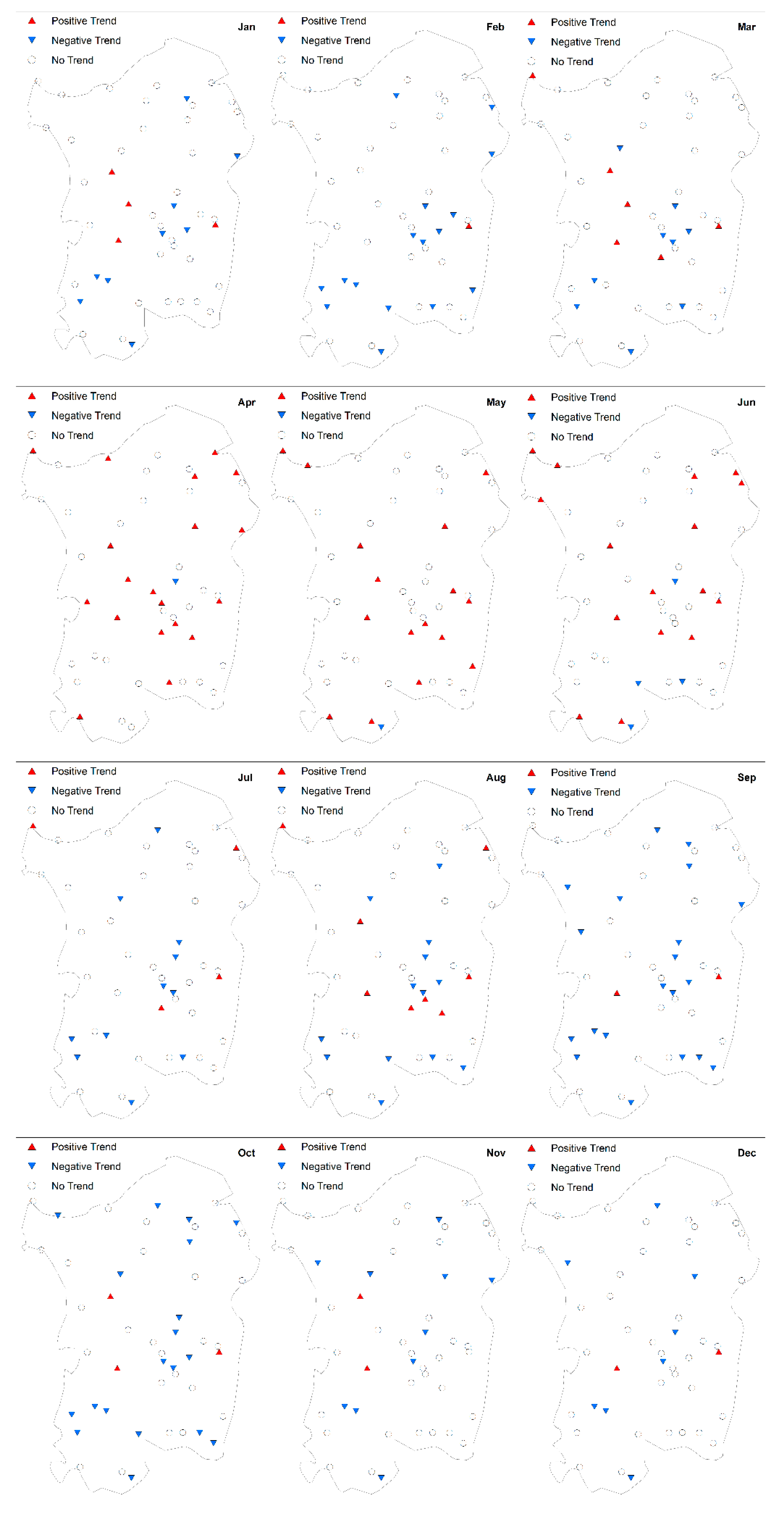
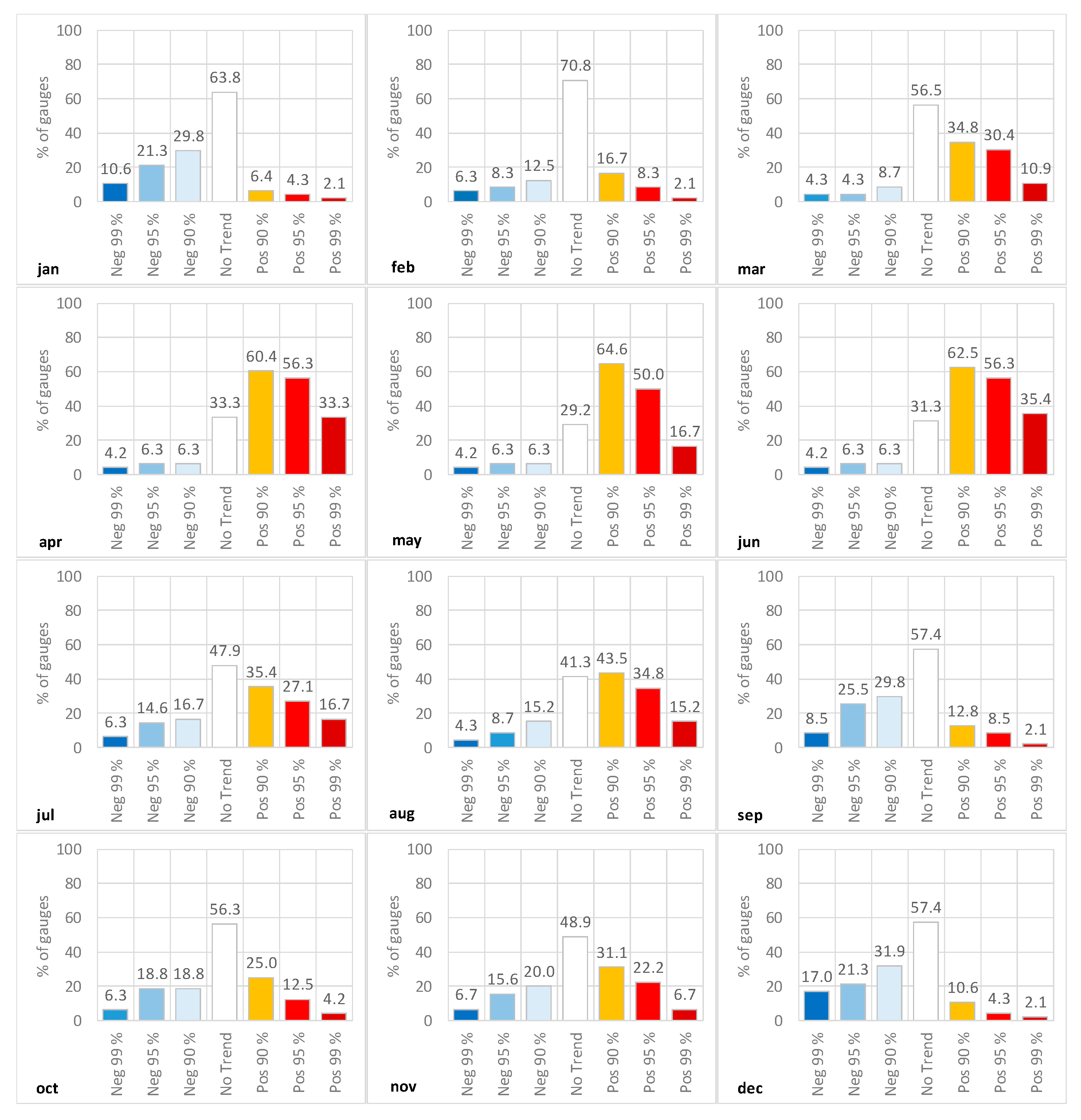
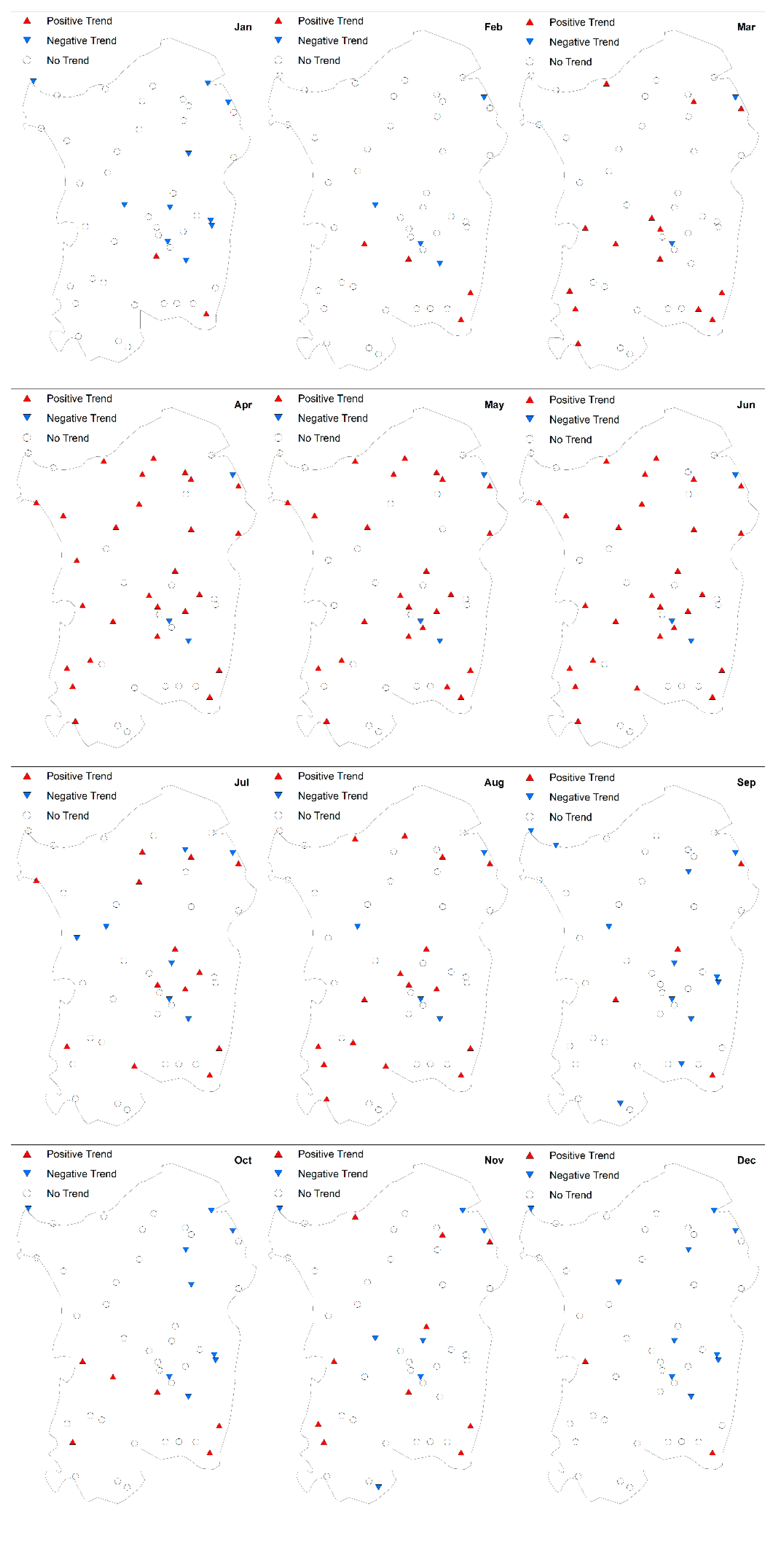
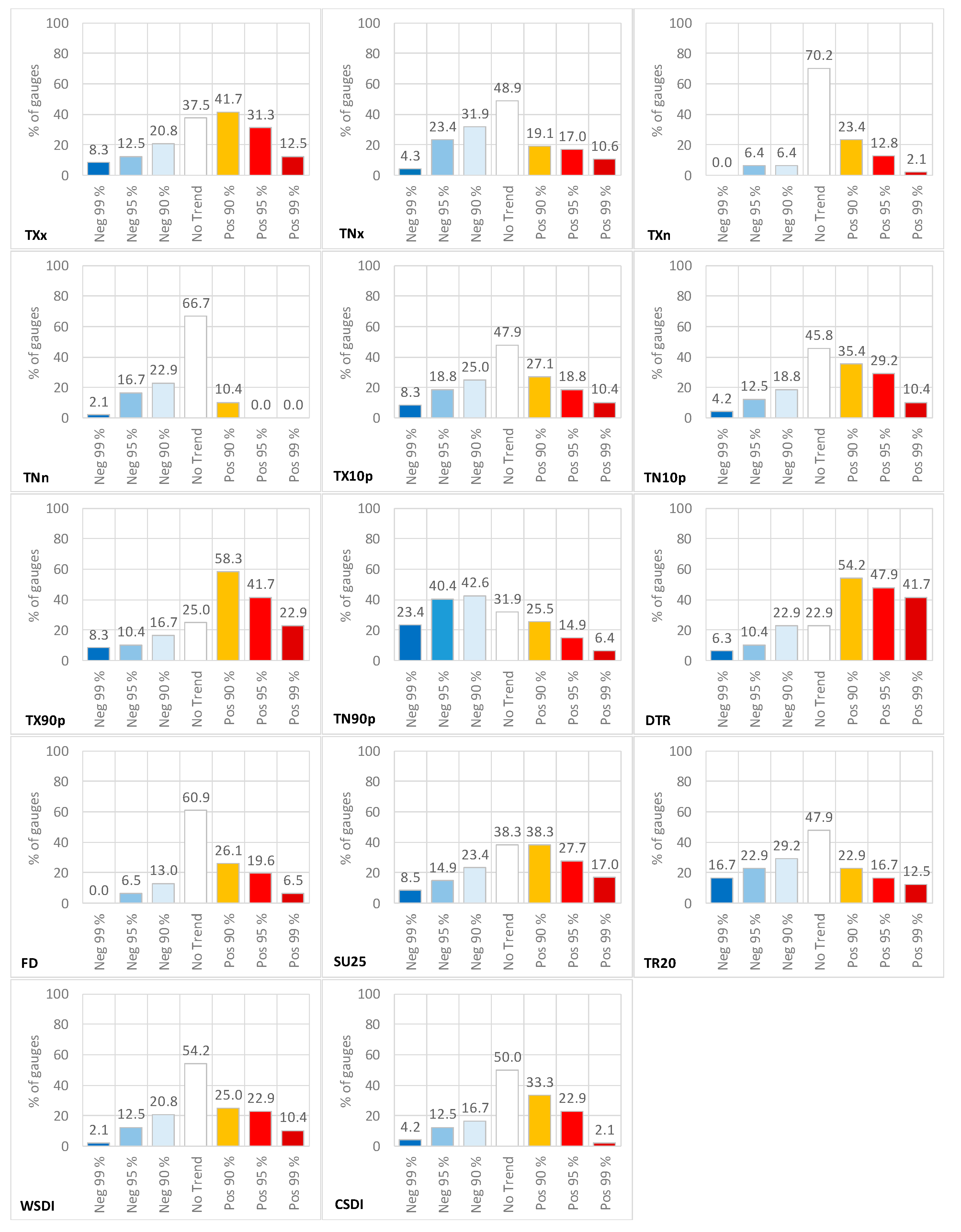
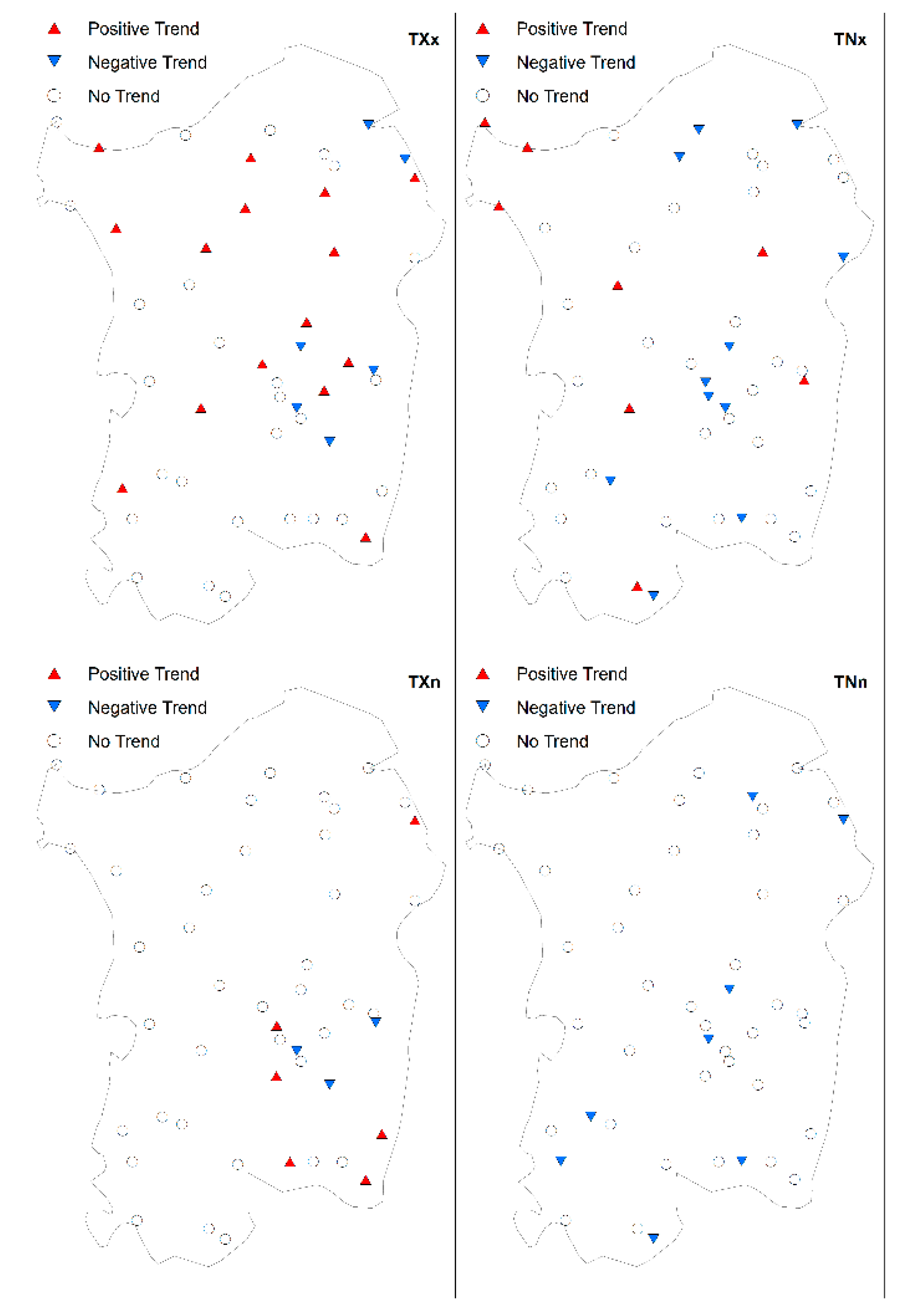
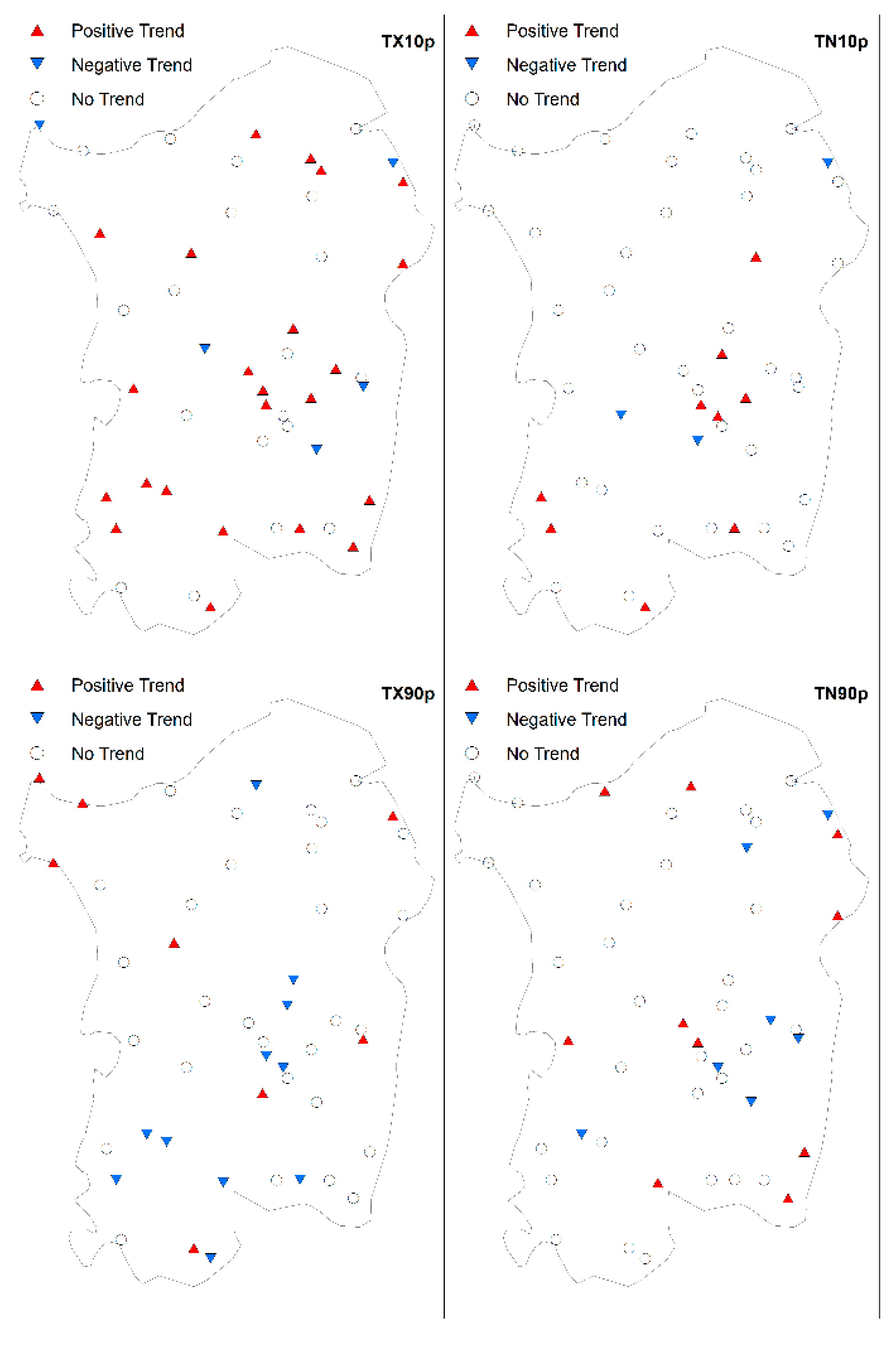

| ID | Mean | Max | Min | CV | SK | KU | ID | Mean | Max | Min | CV | SK | KU |
|---|---|---|---|---|---|---|---|---|---|---|---|---|---|
| 20 | 11.6 | 13.4 | 9.7 | 0.090 | −0.131 | −0.430 | 1490 | 10.4 | 11.8 | 9.3 | 0.064 | 0.473 | −0.204 |
| 80 | 13.4 | 14.8 | 11.8 | 0.065 | −0.157 | −0.818 | 1510 | 9.1 | 10.1 | 7.6 | 0.064 | −0.461 | −0.102 |
| 120 | 8.1 | 10.0 | 6.9 | 0.094 | 0.730 | 0.278 | 1530 | 7.7 | 10.4 | 4.2 | 0.181 | −1.285 | 2.398 |
| 150 | 11.3 | 12.6 | 9.0 | 0.078 | −0.846 | 0.156 | 1535 | 8.0 | 8.8 | 7.2 | 0.048 | 0.155 | 0.237 |
| 260 | 11.2 | 12.8 | 9.6 | 0.077 | 0.029 | −0.806 | 1560 | 8.1 | 9.2 | 5.3 | 0.107 | −2.098 | 6.143 |
| 290 | 10.4 | 11.4 | 9.2 | 0.051 | 0.143 | −0.284 | 1580 | 6.9 | 8.8 | 4.8 | 0.151 | 0.413 | −0.534 |
| 300 | 11.0 | 12.5 | 9.3 | 0.084 | 0.056 | −1.252 | 1770 | 10.3 | 11.9 | 8.8 | 0.086 | 0.490 | −0.533 |
| 440 | 11.7 | 13.0 | 10.1 | 0.050 | −0.444 | 1.694 | 1890 | 12.4 | 13.4 | 11.5 | 0.044 | 0.274 | −0.642 |
| 510 | 11.4 | 12.6 | 9.9 | 0.067 | −0.525 | −0.400 | 1980 | 12.6 | 13.6 | 11.6 | 0.040 | −0.269 | −0.495 |
| 530 | 12.3 | 14.1 | 11.0 | 0.065 | −0.191 | −0.446 | 1990 | 12.2 | 13.1 | 11.0 | 0.053 | −0.427 | −0.966 |
| 580 | 10.7 | 14.6 | 7.7 | 0.214 | 0.633 | −1.156 | 2130 | 10.3 | 11.5 | 8.7 | 0.069 | −0.214 | −0.351 |
| 650 | 12.1 | 12.9 | 10.5 | 0.043 | −1.115 | 1.847 | 2170 | 12.8 | 14.1 | 10.3 | 0.064 | −1.609 | 3.532 |
| 750 | 10.0 | 11.3 | 7.6 | 0.081 | −1.177 | 2.035 | 2240 | 11.3 | 13.7 | 9.9 | 0.092 | 0.718 | −0.215 |
| 910 | 9.3 | 10.8 | 7.3 | 0.100 | −0.343 | −0.429 | 2250 | 11.7 | 14.1 | 7.6 | 0.164 | −0.721 | −0.655 |
| 950 | 7.2 | 9.6 | 4.2 | 0.225 | −0.536 | −1.024 | 2330 | 12.3 | 13.1 | 11.0 | 0.038 | −0.663 | 0.338 |
| 980 | 7.7 | 9.4 | 5.9 | 0.099 | 0.012 | 0.326 | 2390 | 9.5 | 11.4 | 7.4 | 0.115 | −0.451 | −0.485 |
| 1020 | 11.0 | 11.8 | 9.7 | 0.049 | −0.452 | −0.005 | 2400 | 9.6 | 11.0 | 7.5 | 0.114 | −0.700 | −0.698 |
| 1070 | 11.3 | 12.8 | 9.8 | 0.071 | 0.108 | −0.984 | 2440 | 9.2 | 11.7 | 4.4 | 0.149 | −1.668 | 5.978 |
| 1180 | 11.8 | 13.0 | 10.5 | 0.050 | −0.191 | −0.057 | 2500 | 6.7 | 7.4 | 5.8 | 0.069 | −0.251 | −1.111 |
| 1200 | 10.7 | 11.7 | 9.4 | 0.046 | −0.350 | 0.799 | 2560 | 11.5 | 13.1 | 9.8 | 0.071 | −0.207 | −0.016 |
| 1320 | 12.4 | 13.1 | 11.5 | 0.034 | −0.279 | −0.505 | 2570 | 11.1 | 12.4 | 10.1 | 0.057 | 0.559 | −0.513 |
| 1350 | 12.4 | 15.8 | 10.1 | 0.123 | 0.624 | −0.226 | 2580 | 11.7 | 12.7 | 11.0 | 0.040 | 0.615 | −0.113 |
| 1460 | 10.5 | 12.1 | 9.6 | 0.072 | 0.874 | −0.388 | 2640 | 13.0 | 14.9 | 11.7 | 0.058 | 0.463 | 0.140 |
| 1470 | 12.3 | 13.6 | 10.0 | 0.061 | −1.018 | 1.805 | 2660 | 13.3 | 14.7 | 11.7 | 0.051 | −0.081 | −0.018 |
| ID | Mean | Max | Min | CV | SK | KU | ID | Mean | Max | Min | CV | SK | KU |
|---|---|---|---|---|---|---|---|---|---|---|---|---|---|
| 20 | 22.4 | 25.0 | 19.2 | 0.059 | 0.251 | 0.983 | 1490 | 21.0 | 22.9 | 19.3 | 0.042 | 0.052 | −0.200 |
| 80 | 22.0 | 24.6 | 20.2 | 0.041 | 0.757 | 1.564 | 1510 | 20.4 | 22.0 | 17.8 | 0.047 | −0.913 | 1.563 |
| 120 | 19.1 | 22.0 | 17.7 | 0.054 | 0.946 | 1.181 | 1530 | 18.7 | 20.2 | 14.5 | 0.090 | −1.555 | 1.789 |
| 150 | 20.7 | 22.8 | 18.2 | 0.055 | −0.690 | −0.051 | 1535 | 19.9 | 21.8 | 18.3 | 0.050 | 0.227 | −0.730 |
| 260 | 22.9 | 25.0 | 21.0 | 0.042 | 0.034 | −0.605 | 1560 | 21.6 | 22.8 | 20.3 | 0.031 | 0.163 | −0.709 |
| 290 | 17.9 | 20.1 | 15.6 | 0.075 | 0.321 | −1.082 | 1580 | 21.2 | 23.4 | 19.3 | 0.045 | −0.015 | 0.053 |
| 300 | 22.2 | 24.3 | 20.1 | 0.037 | −0.167 | 1.543 | 1770 | 18.4 | 20.0 | 16.3 | 0.055 | −0.272 | −0.376 |
| 440 | 22.8 | 23.9 | 21.8 | 0.028 | 0.482 | −0.773 | 1890 | 20.0 | 22.7 | 17.6 | 0.084 | 0.129 | −1.487 |
| 510 | 22.8 | 24.9 | 17.0 | 0.072 | −1.871 | 5.894 | 1980 | 21.0 | 22.3 | 19.1 | 0.046 | −0.547 | −0.772 |
| 530 | 22.2 | 24.1 | 20.4 | 0.045 | −0.248 | −0.784 | 1990 | 18.6 | 23.6 | 16.4 | 0.129 | 1.165 | −0.188 |
| 580 | 22.0 | 23.7 | 20.0 | 0.052 | −0.043 | −1.185 | 2130 | 18.4 | 19.8 | 17.3 | 0.037 | 0.271 | −0.153 |
| 650 | 22.6 | 24.2 | 20.5 | 0.040 | −0.507 | 0.357 | 2170 | 23.0 | 24.6 | 20.6 | 0.043 | −0.608 | 0.137 |
| 750 | 19.5 | 22.3 | 17.9 | 0.060 | 1.136 | 0.777 | 2240 | 18.9 | 22.5 | 17.3 | 0.067 | 0.959 | 1.222 |
| 910 | 17.1 | 19.5 | 14.9 | 0.071 | 0.186 | −0.537 | 2250 | 19.8 | 24.3 | 18.1 | 0.066 | 1.745 | 4.500 |
| 950 | 18.6 | 20.9 | 16.1 | 0.063 | −0.152 | −0.513 | 2330 | 23.3 | 24.8 | 18.2 | 0.055 | −2.213 | 7.812 |
| 980 | 18.9 | 20.4 | 16.6 | 0.062 | −0.701 | −0.567 | 2390 | 19.4 | 22.0 | 17.9 | 0.051 | 0.344 | −0.013 |
| 1020 | 19.8 | 21.8 | 18.1 | 0.043 | 0.064 | 0.260 | 2400 | 17.9 | 21.2 | 12.3 | 0.142 | −1.245 | 0.579 |
| 1070 | 20.1 | 22.7 | 17.5 | 0.066 | −0.143 | −0.860 | 2440 | 18.4 | 23.0 | 14.6 | 0.084 | 0.419 | 3.251 |
| 1180 | 19.4 | 20.2 | 18.4 | 0.027 | −0.404 | −0.951 | 2500 | 18.0 | 19.6 | 16.6 | 0.047 | 0.008 | −1.066 |
| 1200 | 17.7 | 18.6 | 16.2 | 0.033 | −0.639 | 0.094 | 2560 | 21.5 | 23.4 | 17.7 | 0.075 | −0.940 | −0.232 |
| 1320 | 22.3 | 23.5 | 20.7 | 0.028 | −0.573 | 0.613 | 2570 | 19.7 | 21.5 | 17.8 | 0.049 | −0.418 | −0.384 |
| 1350 | 21.0 | 23.4 | 18.6 | 0.055 | −0.337 | −0.145 | 2580 | 21.9 | 23.8 | 18.7 | 0.062 | −0.696 | −0.392 |
| 1460 | 22.8 | 24.1 | 20.1 | 0.045 | −1.271 | 1.187 | 2640 | 22.3 | 23.6 | 20.8 | 0.034 | −0.135 | −0.629 |
| 1470 | 20.0 | 22.3 | 17.9 | 0.063 | 0.409 | −1.081 | 2660 | 22.7 | 24.4 | 21.0 | 0.032 | 0.310 | 0.966 |
| Index | Name | Definition | Units |
|---|---|---|---|
| TXx | Max Tmax | Yearly maximum value of daily maximum temperature | °C |
| TNx | Max Tmin | Yearly maximum value of daily minimum temperature | °C |
| TXn | Min Tmax | Yearly minimum value of daily maximum temperature | °C |
| TNn | Min Tmin | Yearly minimum value of daily minimum temperature | °C |
| TN10p | Cold nights | Yearly number of days with daily minimum temperature < 10th percentile | days |
| TX10p | Cold days | Yearly number of days with maximum temperature < 10th percentile | days |
| TN90p | Warm nights | Yearly number of days with daily minimum temperature > 90th percentile | days |
| TX90p | Warm days | Yearly number of days with maximum temperature > 90th percentile | days |
| DTR | Diurnal temperature range | Yearly mean difference between daily maximum and minimum temperature | °C |
| FD | Frost days | Yearly number of days with daily minimum temperature < 0 °C | days |
| SU25 | Summer days | Yearly number of days with daily maximum temperature > 25 °C | days |
| TR20 | Tropical nights | Yearly number of days with daily minimum temperature > 20 °C | days |
| WSDI | Warm spell duration indicator | Yearly number of days with at least six consecutive days of maximum temperature > 90th percentile | days |
| CSDI | Cold spell duration indicator | Yearly number of days with at least six consecutive days of minimum temperature < 10th percentile | days |
© 2020 by the authors. Licensee MDPI, Basel, Switzerland. This article is an open access article distributed under the terms and conditions of the Creative Commons Attribution (CC BY) license (http://creativecommons.org/licenses/by/4.0/).
Share and Cite
Caloiero, T.; Guagliardi, I. Temporal Variability of Temperature Extremes in the Sardinia Region (Italy). Hydrology 2020, 7, 55. https://doi.org/10.3390/hydrology7030055
Caloiero T, Guagliardi I. Temporal Variability of Temperature Extremes in the Sardinia Region (Italy). Hydrology. 2020; 7(3):55. https://doi.org/10.3390/hydrology7030055
Chicago/Turabian StyleCaloiero, Tommaso, and Ilaria Guagliardi. 2020. "Temporal Variability of Temperature Extremes in the Sardinia Region (Italy)" Hydrology 7, no. 3: 55. https://doi.org/10.3390/hydrology7030055
APA StyleCaloiero, T., & Guagliardi, I. (2020). Temporal Variability of Temperature Extremes in the Sardinia Region (Italy). Hydrology, 7(3), 55. https://doi.org/10.3390/hydrology7030055






